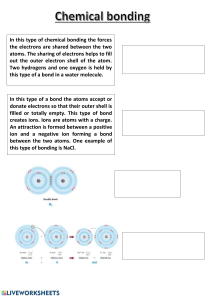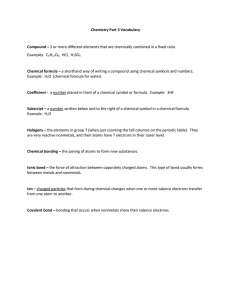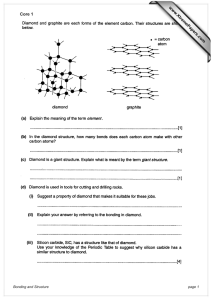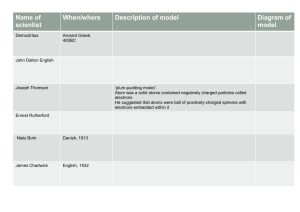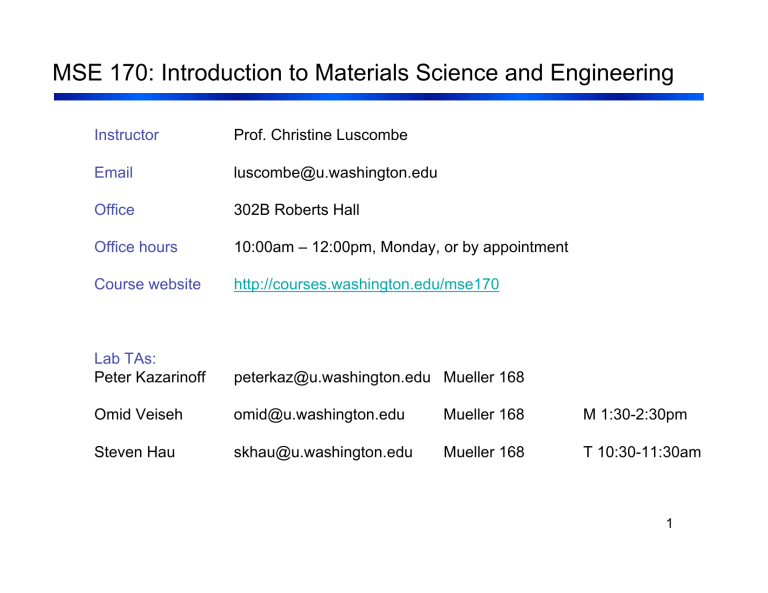
MSE 170: Introduction to Materials Science and Engineering Instructor Prof. Christine Luscombe Email luscombe@u.washington.edu Office 302B Roberts Hall Office hours 10:00am – 12:00pm, Monday, or by appointment Course website http://courses.washington.edu/mse170 Lab TAs: Peter Kazarinoff peterkaz@u.washington.edu Mueller 168 Omid Veiseh omid@u.washington.edu Mueller 168 M 1:30-2:30pm Steven Hau skhau@u.washington.edu Mueller 168 T 10:30-11:30am 1 What is Materials Science and Engineering? An interdisciplinary field that addresses the fundamental relationships between the Processing, Structure and Properties of materials and develops them for the desired technological application (Performance). 2 Materials through the ages Stone Age (beginning of life – 3000 BC) Feature: Using naturally occurring materials with only changes in shape 3 Materials through the ages Bronze Age (3000 BC – 1200 BC) Copper and Tin alloy Ability to modify materials by refining (using heat), chemical modifications (alloying) and mechanical deformation (cold working) Imperfection (Ch. 4) Diffusion (Ch. 5) Phase diagram (Ch. 9) Metal Processing (Ch. 11) 4 Materials through the ages Iron Age (1200 BC – Present) Casting and alloying wasn’t perfected until 16th century Mastery of Steel (Iron alloy) technology enables Industrial Revolution in the 18th and 19th century Ability to heat treat at high temperature, control microstructure at different length scale and ability to design specific microstructures for specific properties Phase transformation (Ch. 10) 5 Materials through the ages Plastic Age (1940 - Present) Discovery of polymers, and the ability to synthesize and process polymers. 6 Materials through the ages Silicon Age (1950 - Present) Commercialization of silicon technology (integrated circuits, electronic devices, etc…) leads to the information age, which gives boost to human productivity Electronic Prop. (Ch.18) Thermal Prop. (Ch.19) Magnetic Prop. (Ch.20) Optical Prop. (Ch.21) Ability to control alloying accurately, ability to make thin films 7 Future 1. Nanotechnology - Synthesis and characterizations of nanomaterials and nanostructure 2. Biotechnology - biomimetics and biomaterials 3. Energy/Environmental - Next generation energy conversion 4. Information Technology - Materials informatics 8 What is Materials Science and Engineering? An interdisciplinary field that addresses the fundamental relationships between the Processing, Structure and Properties of materials and develops them for the desired technological application (Performance). 9 Two Forms of Carbon Diamond Graphite • A structure of carbon only produced at high temperature and pressure. • A structure of carbon that is in equilibrium (it is stable and will not change form over time). • The hardest known material. • It is soft. Atomic structure and interatomic bonding (Ch.2) Crystallography (Ch. 3), Imperfection (Ch. 4) 10 Ceramics Ch. 12 Materials Metals Ch. 11 Polymers Ch.14 and 15 Composite Ch. 16 11 Atomic structure Nucleus Neutron Quarks Gluons Electron Protons BOHR ATOM orbital electrons: n = principal quantum number 1 2 n=3 Nucleus: Z = # protons = 1 for hydrogen to 94 for plutonium Atomic mass A ≈ Z + N N = # neutrons 12 Electronic structure Valence electrons determine all of the following properties: • • • • Chemical Electrical Thermal Optical Electrons have wavelike and particulate properties. • This means that electrons are in orbitals defined by a probability. • Each orbital at discrete energy level determined by quantum numbers. Quantum # Designation n = principal (energy level-shell) K, L, M, N, O (1, 2, 3, etc.) l = subsidiary (orbitals) s, p, d, f (0, 1, 2, 3,…, n -1) ml = magnetic 1, 3, 5, 7 (-l to +l) ms = spin ½, -½ 13 Electronic structure Number of electrons Principal quantum no. Shell designation Subshells No. of states Per subshell Per shell 1 K s 1 2 2 2 L s 1 2 8 p 3 6 s 1 2 p 3 6 d 5 10 s 1 2 p 3 6 f d d 5 10 d f 7 14 p s 3 4 M N 18 g f 32 p s d p s p s s 1 2 3 4 5 14 Electron energy states Electrons... • have discrete energy states • tend to occupy lowest available energy state. 4d 4p N-shell n = 4 3d 4s Energy 3p 3s 2p 2s 1s M-shell n = 3 L-shell n = 2 K-shell n = 1 Adapted from Fig. 2.4, 15 Callister 7e. Electronic configuration ex: Fe - atomic # = 26 1s2 2s2 2p6 3s2 3p6 3d 6 4s2 4d 4p valence electrons N-shell n = 4 3d 4s Energy 3p 3s 2p 2s 1s M-shell n = 3 L-shell n = 2 K-shell n = 1 Adapted from Fig. 2.4, 16 Callister 7e. Survey of elements • Most elements: Electron configuration not stable. Element Hydrogen Helium Lithium Beryllium Boron Carbon ... Atomic # 1 2 3 4 5 6 Neon 10 Sodium Electron configuration 1s 1 1s 2 (stable) 1s 2 2s 1 1s 2 2s 2 1s 2 2s 2 2p 1 1s 2 2s 2 2p 2 ... 6 11 1s 2 2s 2 2p 1s 2 2s 2 2p Magnesium 12 1s 2 2s 2 2p 6 3s 2 Aluminum ... 13 1s 2 2s 2 2p ... 6 3s 2 3p 1 Argon ... 18 ... 1s 2 2s 2 2p ... 6 3s 2 3p 6 Krypton 36 1s 2 2s 2 2p 6 3s 2 3p 6 3d 10 (stable) 6 3s 1 • Why? Valence (outer) shell usually not filled completely. (stable) 4s 2 4p 6 (stable) Adapted from Table 2.2, Callister 7e. 17 The periodic table Li Be Na Mg K Ca Sc Rb Sr Y Cs Ba inert gases accept 1e accept 2e give up 3e H give up 2e give up 1e • Columns: Similar Valence Structure He O F Ne S Cl Ar Se Br Kr Te I Xe Po At Rn Fr Ra Electropositive elements: Readily give up electrons to become + ions. Electronegative elements: Readily acquire electrons to become - ions. Adapted from 18 Fig. 2.6, Callister 7e. Electronegativity • Ranges from 0.7 to 4.0, • Large values: tendency to acquire electrons. Smaller electronegativity Larger electronegativity Adapted from Fig. 2.7, Callister 7e. (Fig. 2.7 is adapted from Linus Pauling, The Nature of the Chemical Bond, 3rd edition, Copyright 1939 and 1940, 3rd edition. Copyright 1960 by Cornell University. 19 Bonding forces and energies • Attractive force, FA r Attraction Attractive force, FA E= " Fdr r EN = 0 Interatomic separation r Repulsion Force F + • Repulsive force, FR r # F dr = # F dr + # F dr N " ! A " R " = EA + ER Repulsive force, FR - r ! Net force, FN Repulsive energy ER ! Interatomic separation r Net energy EN Attractive energy EA 20 Properties from bonding • Bond length, r • Melting Temperature, Tm Energy r r • Bond energy, Eo Energy r o r smaller Tm unstretched length o Eo larger Tm r = Tm is larger if Eo is larger. “bond energy” 21 Properties from bonding: thermal expansion coefficient • Coefficient of thermal expansion, α length, coeff. thermal expansion Lo unheated, T1 Δ L Δ L L o heated, T2 = α (T 2 -T 1 ) • α ~ symmetry at ro Energy unstretched length r o Eo Eo r α is larger if Eo is smaller. larger α smaller α 22 Properties from bonding: modulus E F = kx r Attraction 0 Repulsion Force F + 23 Types of bonding: ionic • Occurs between + and - ions. • Requires electron transfer. • Large difference in electronegativity required. • Example: NaCl Na (metal) Cl (nonmetal) unstable unstable electron Na (cation) stable - + Coulombic Cl (anion) stable Attraction 24 Examples of ionic bonding • Predominant bonding in Ceramics NaCl MgO CaF 2 CsCl Give up electrons Acquire electrons Adapted from Fig. 2.7, Callister 7e. (Fig. 2.7 is adapted from Linus Pauling, The Nature of the Chemical Bond, 3rd edition, Copyright 1939 and 1940, 3rd edition. Copyright 1960 by Cornell University. 25 Covalent bonding •similar electronegativity ∴ share electrons •bonds determined by valence – s & p orbitals dominate bonding •Example: CH4 C: has 4 valence e-, needs 4 more H: has 1 valence e-, needs 1 more CH4 H H C Electronegativities are comparable. shared electrons from carbon atom H shared electrons H from hydrogen atoms Adapted from Fig. 2.10, Callister 7e. 26 Metallic bonding •Ions in a sea of electrons •Attraction between free electrons and metal ions 27 Ionic-covalent mixed bonding % ionic character = # (X A "X B )2 & " % (x 4 %1" e ( % ( $ ' ( 100 %) where XA & XB are Pauling electronegativities ! Example: MgO XMg = 1.3 XO = 3.5 & (3.5 '1.3 )2 ' $ 4 % ionic character = $1 ' e $ % # ! ! x (100%) = 70.2% ionic ! " 28 Secondary bonding Arises from interaction between dipoles • Fluctuating dipoles example: liquid H2 asymmetric electron clouds + - H2 + - H H2 H H secondary bonding H secondary bonding Adapted from Fig. 2.13, Callister 7e. • Permanent dipoles-molecule induced -general case: -example: liquid HCl -example: polymer + H - Cl secondary bonding + secondary bonding H secon dary bond ing Adapted from Fig. 2.14, Callister 7e. Cl secondary bonding 29 Summary Type Bond Energy Comments Ionic Large! Non-directional (ceramics) Covalent Variable Diamond (large) Bismuth (small) Directional (semiconductors, ceramics, polymer chains) Metallic Variable Tungsten (large) Mercury (small) Non-directional (metals) Smallest Directional Interchain (polymer) Intermolecular Secondary Ceramics (Ionic & covalent bonding) Large bond energy Large Tm and E, small α Metals (Metallic bonding) Variable bond energy Moderate Tm, E, and α Polymers (Covalent & secondary) Directional properties, Secondary bonding dominates Small Tm and E, large α 30 Energy and packing • Non dense, random packing Energy typical neighbor bond length typical neighbor bond energy r Energy • Dense, ordered packing typical neighbor bond length typical neighbor bond energy r Dense, ordered packed structures tend to have lower energies. 31 Materials and packing Crystalline materials... • atoms pack in periodic, 3D arrays • typical of: -metals -many ceramics -some polymers crystalline SiO2 Adapted from Fig. 3.22(a), Callister 7e. Si Oxygen Noncrystalline materials... • atoms have no periodic packing • occurs for: -complex structures -rapid cooling "Amorphous" = Noncrystalline noncrystalline SiO2 Adapted from Fig. 3.22(b), Callister 7e. 32 Crystals Unit cell: smallest repetitive volume which contains the complete lattice pattern of a crystal. 7 crystal systems 14 crystal lattices Lattice points: 3D array of points which coincides with atom positions. Fig. 3.4, Callister 7e. a, b, and c are the lattice constants 33 Simple cubic structure (SC) • Rare due to low packing density (only Po has this structure) • Close-packed directions are cube edges. • Coordination # = 6 (# nearest neighbors) 1 atoms/unit cell: 8 corners x 1/8 (Courtesy P.M. Anderson) 34 Face centered cubic structure (FCC) • Atoms touch each other along face diagonals. --Note: All atoms are identical; the face-centered atoms are shaded differently only for ease of viewing. ex: Al, Cu, Au, Pb, Ni, Pt, Ag • Coordination # = 12 Adapted from Fig. 3.1, Callister 7e. 4 atoms/unit cell: 6 face x 1/2 + 8 corners x 1/8 (Courtesy P.M. Anderson) 35 Atomic packing factor (APF): FCC Volume of atoms in unit cell* APF = Volume of unit cell *assume hard spheres volume 2a atoms unit cell a Adapted from Fig. 3.1(a), Callister 7e. close-packed directions contains 6 x 1/2 + 8 x 1/8 = 4 atoms/unit cell 4 4 π R 3 atom 3 APF = a3 volume unit cell • APF for a FCC structure = 0.74 Maximum achievable APF 36 Theoretical density, ρ Density = ρ = Mass of atoms in unit cell Total volume of unit cell where nA VC NA ρ = n = number of atoms/unit cell A = atomic weight VC = Volume of unit cell = a3 for cubic NA = Avogadro’s number = 6.023 x 1023 atoms/mol Ex: Cu (FCC) A = 63.54 g/mol R = 0.128 nm n=4 g atoms unit cell ρ= volume unit cell 4 63.54 a3 ρtheoretical = 8.9 g/cm3 mol ρactual = 8.94 g/cm3 6.023 x 1023 a = 2R 2 atoms mol 37 Body centered cubic structure (BCC) • Atoms touch each other along cube diagonals. --Note: All atoms are identical; the center atom is shaded differently only for ease of viewing. ex: Cr, W, Fe (α), Tantalum, Molybdenum Adapted from Fig. 3.2, Callister 7e. 2 atoms/unit cell: 1 center + 8 corners x 1/8 • Coordination # = 8 (Courtesy P.M. Anderson) 38 Atomic packing factor (APF): BCC volume R atoms a unit cell 2 4 π (√ 3 a/4)3 3 atom APF = a3 volume unit cell • APF for a FCC structure = 0.68 39 FCC stacking sequence • ABCABC... Stacking Sequence • 2D Projection B A sites B sites A B C B C B B C B B C sites • FCC Unit Cell A B C 40 Hexagonal close-packed structure (hcp) • ABAB... Stacking Sequence • 3D Projection • 2D Projection c a A sites Top layer B sites Middle layer A sites Bottom layer Adapted from Fig. 3.3(a), Callister 7e. • Coordination # = 12 • APF = 0.74 6 atoms/unit cell ex: Cd, Mg, Ti, Zn • c/a = 1.633 41
